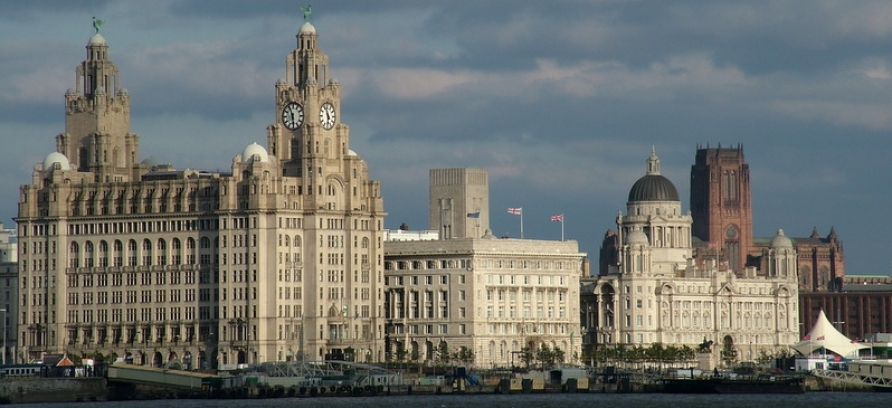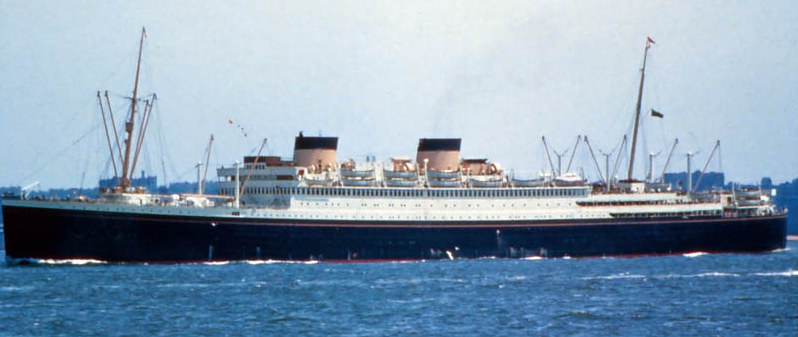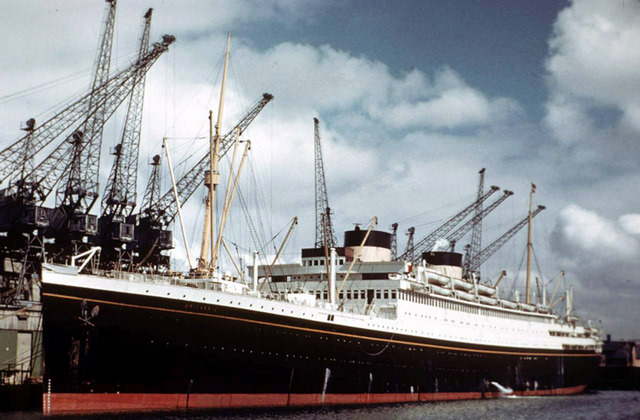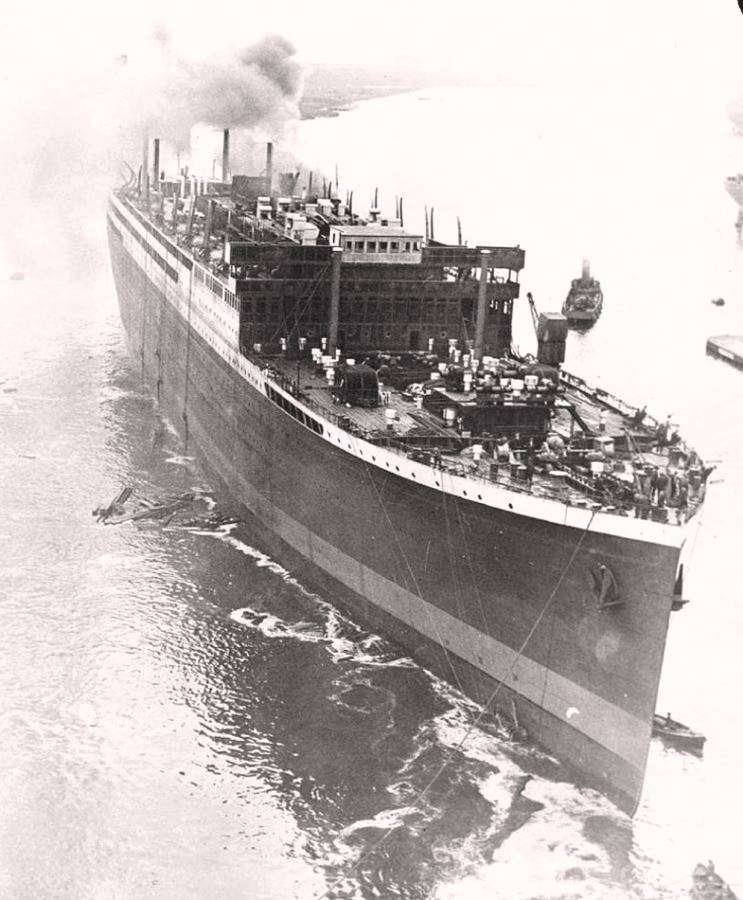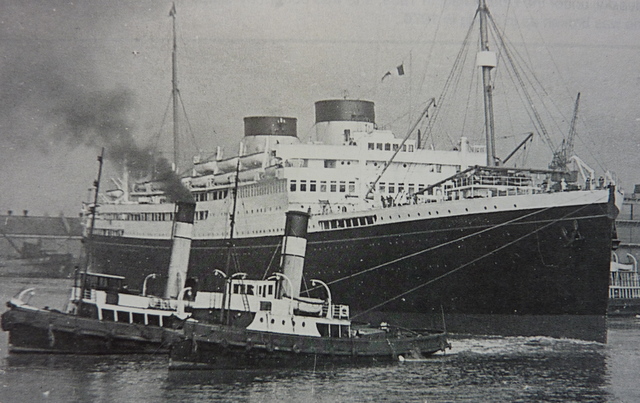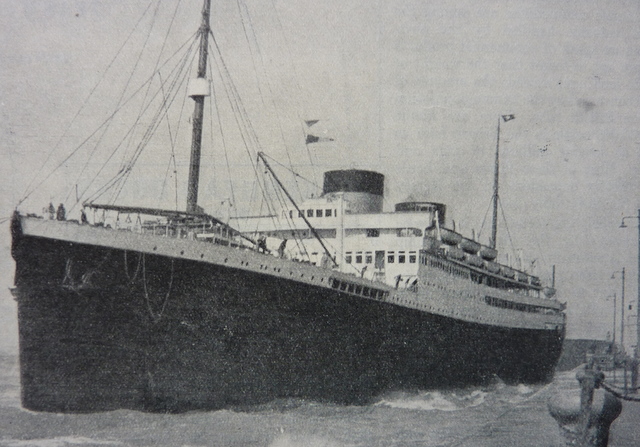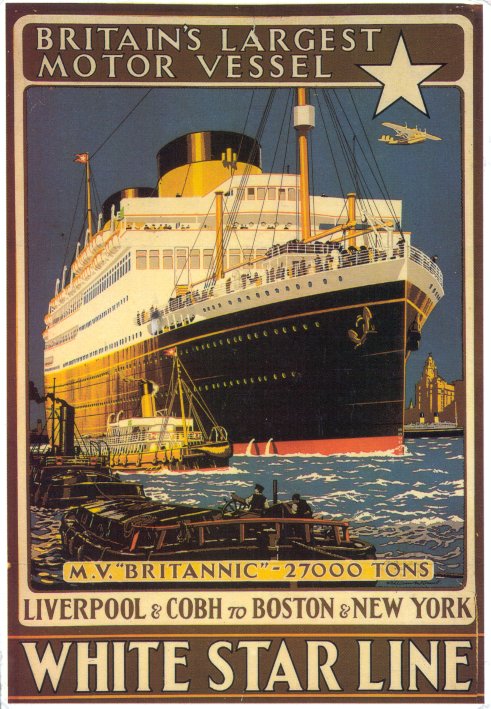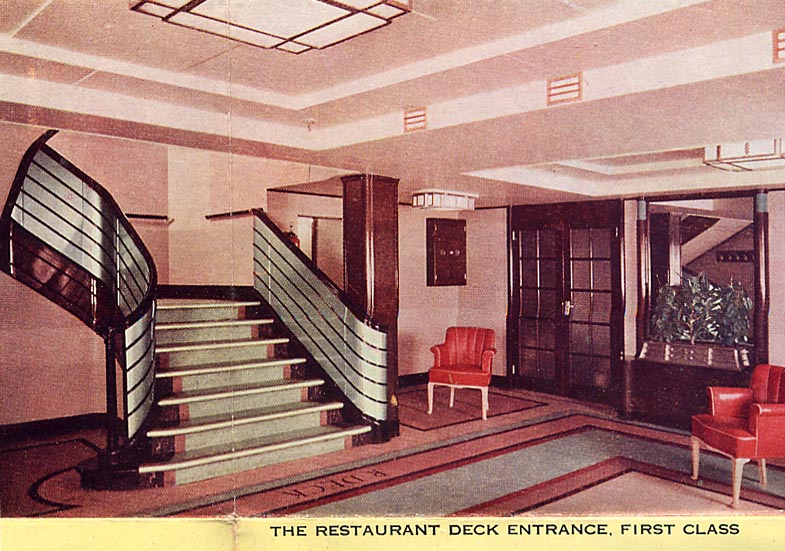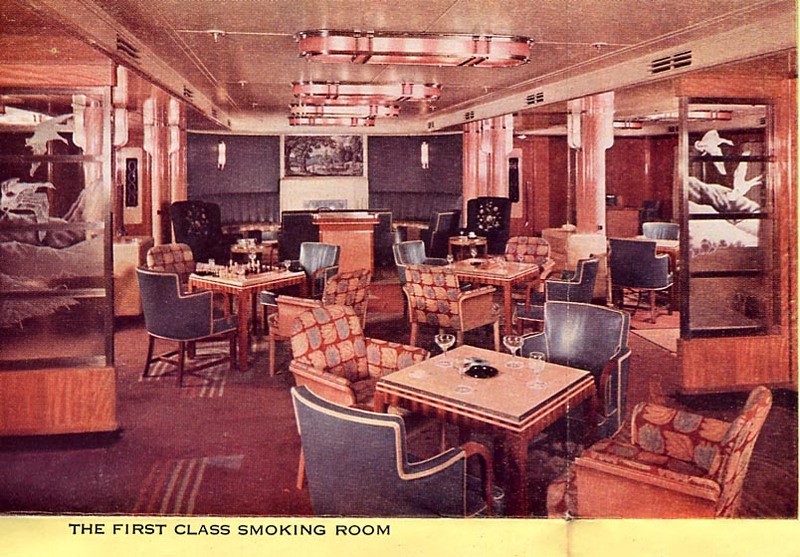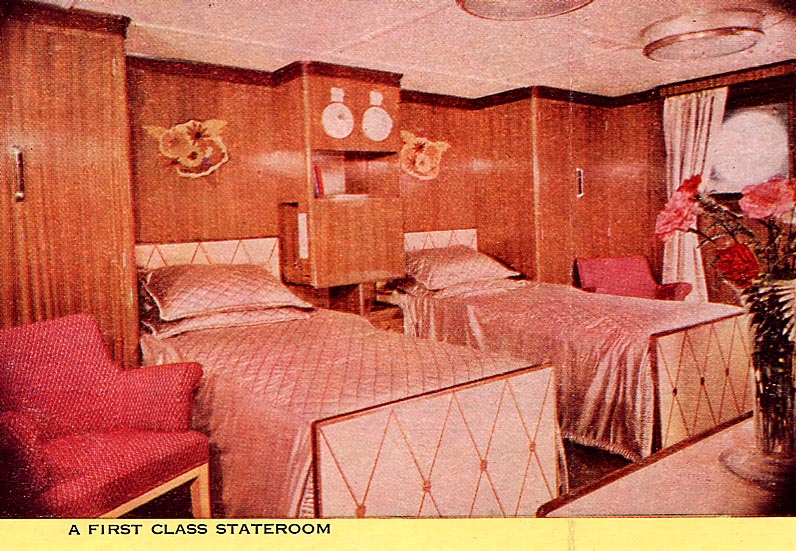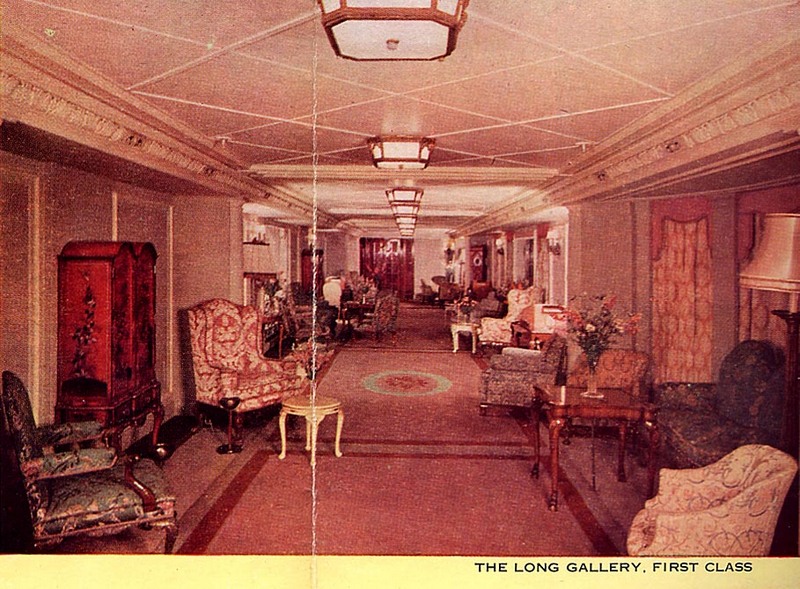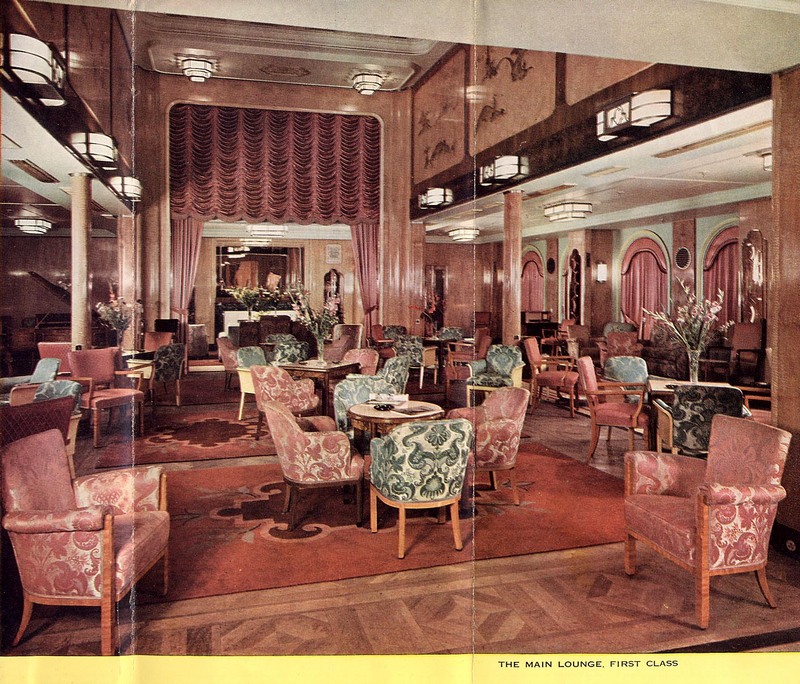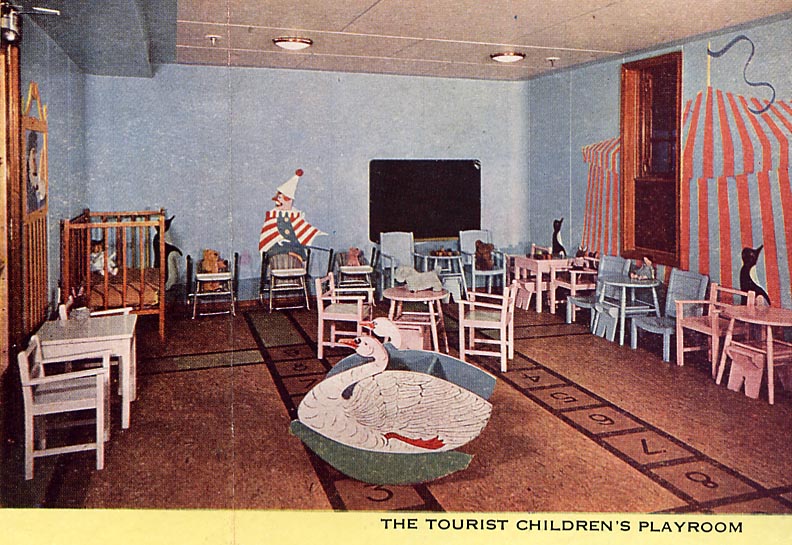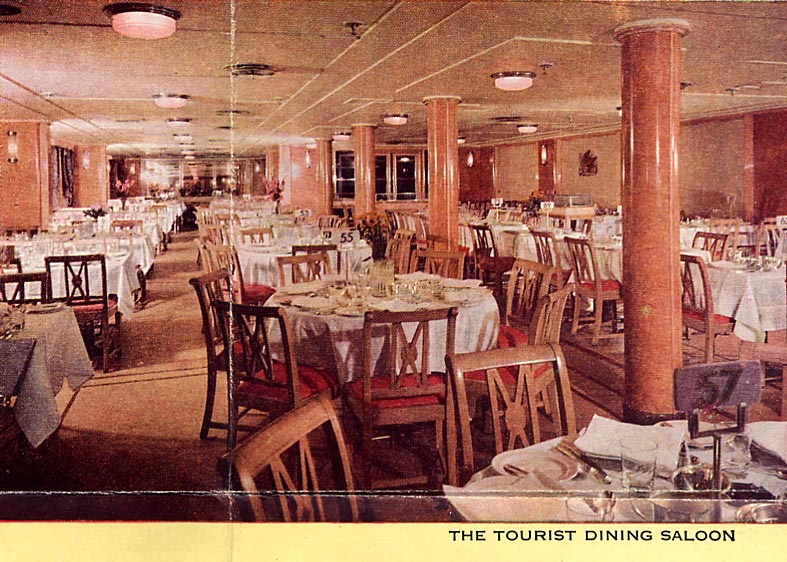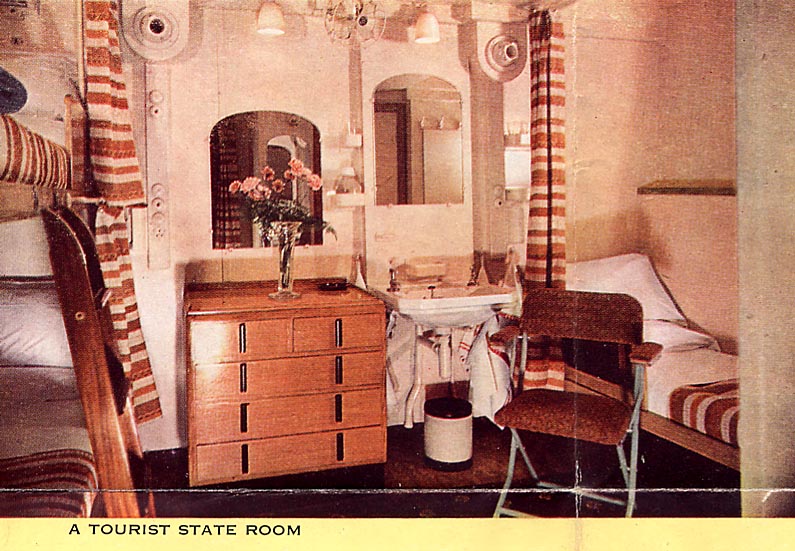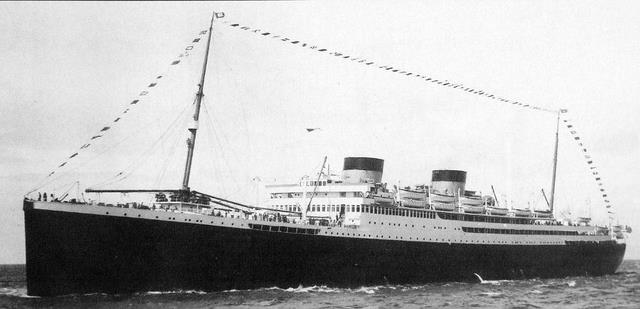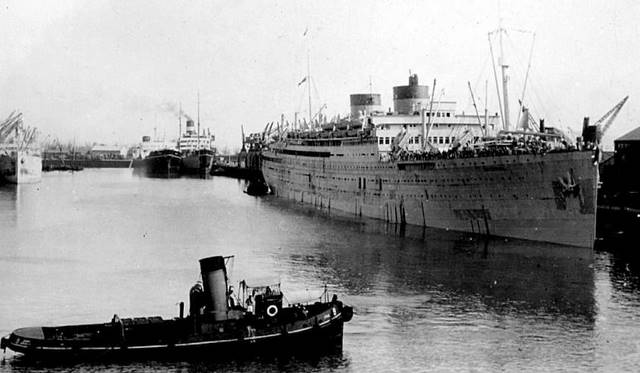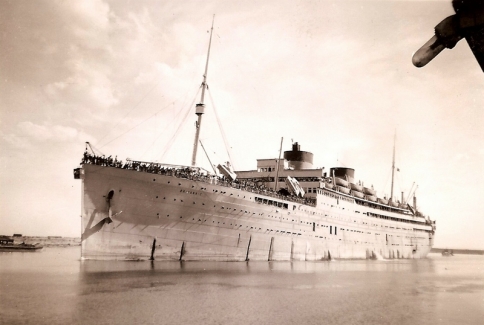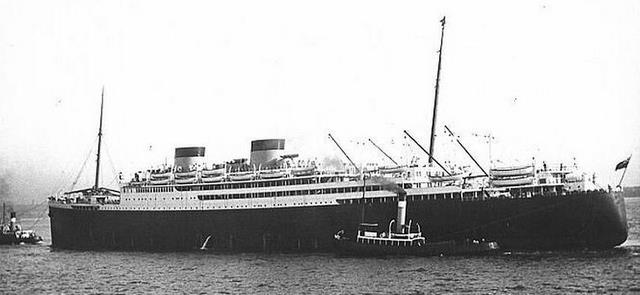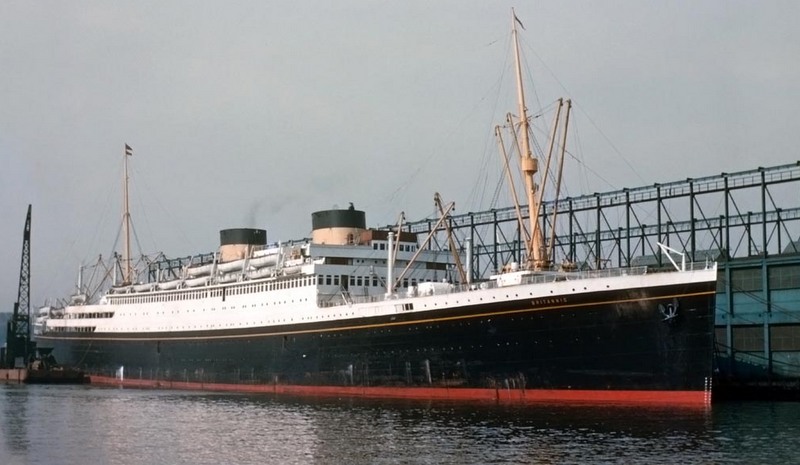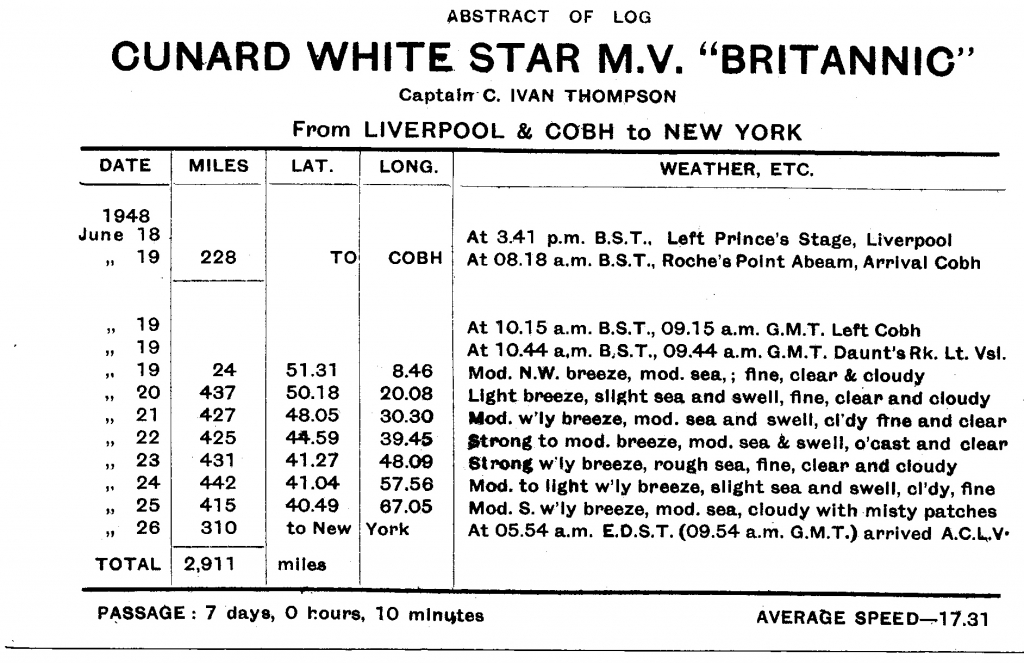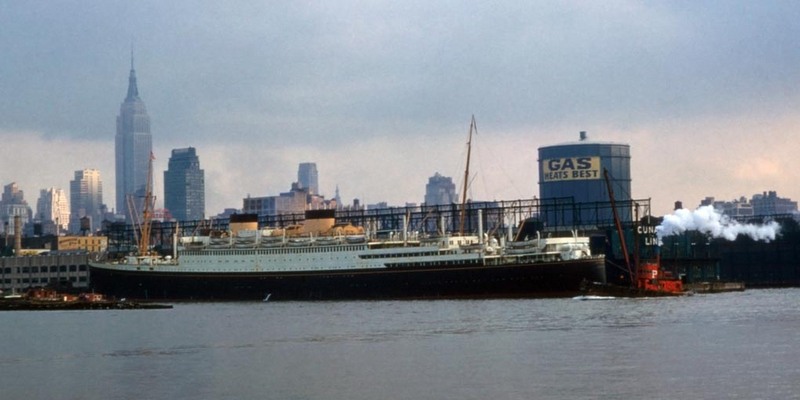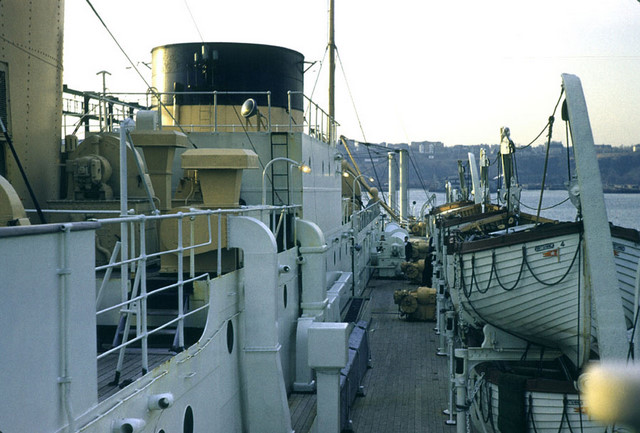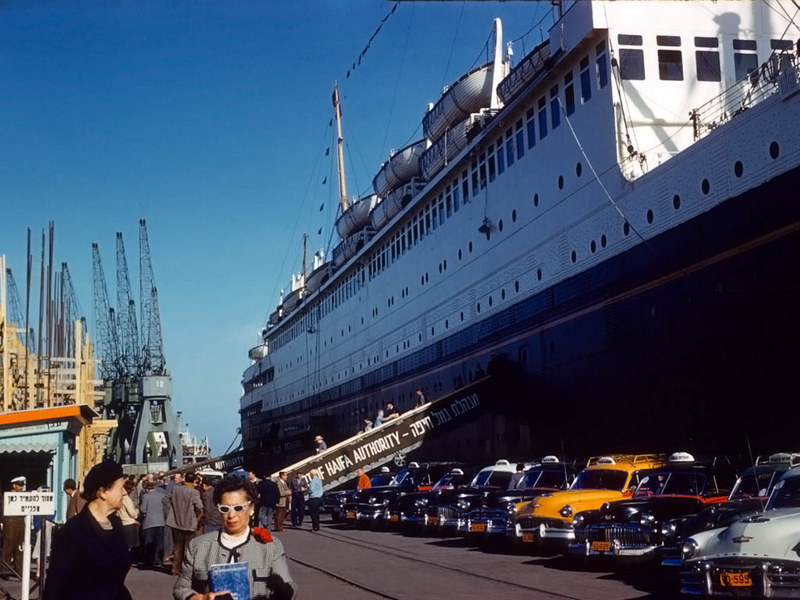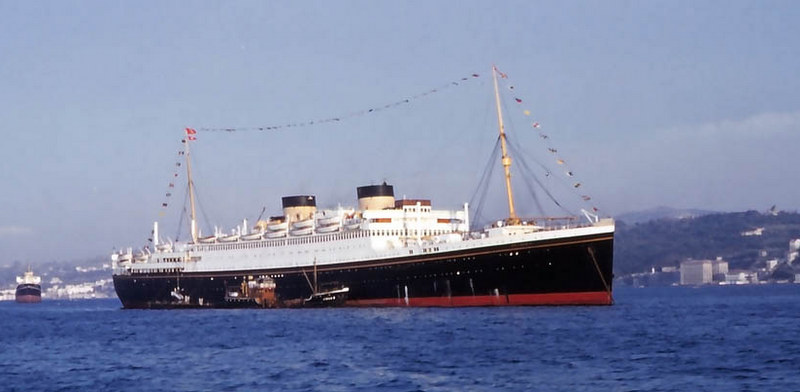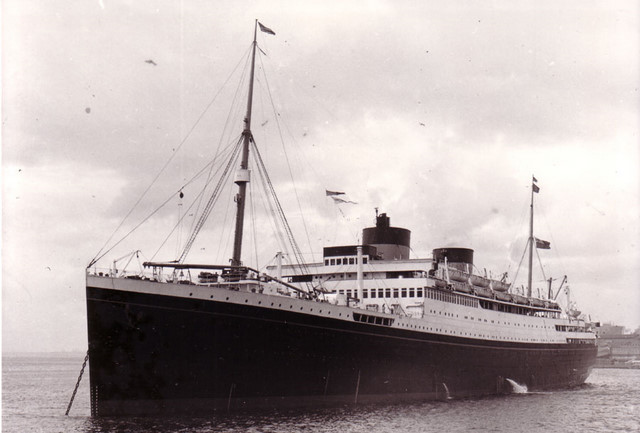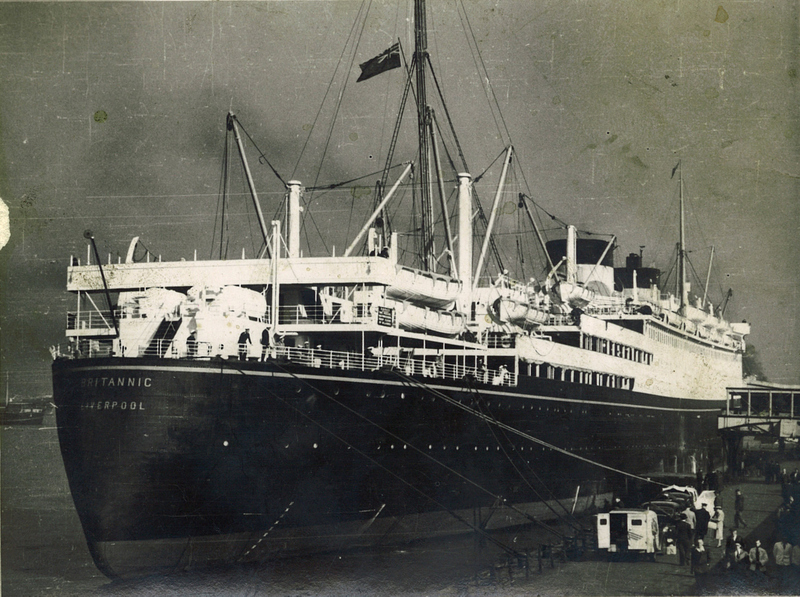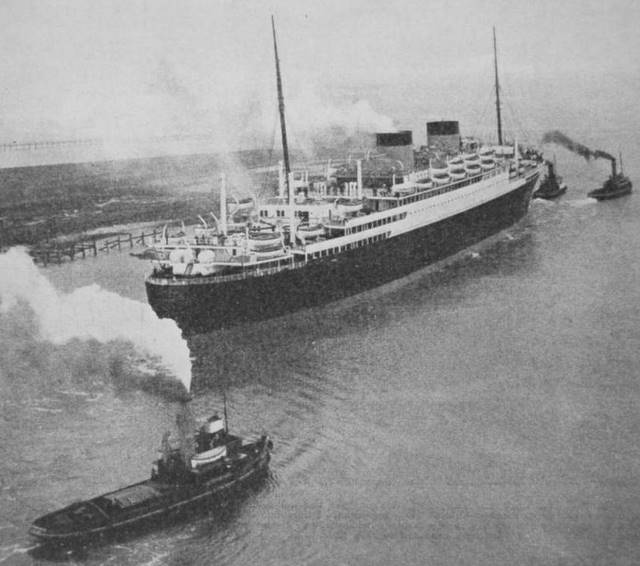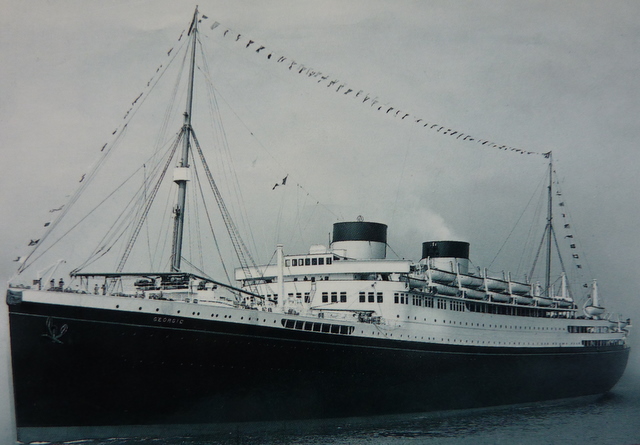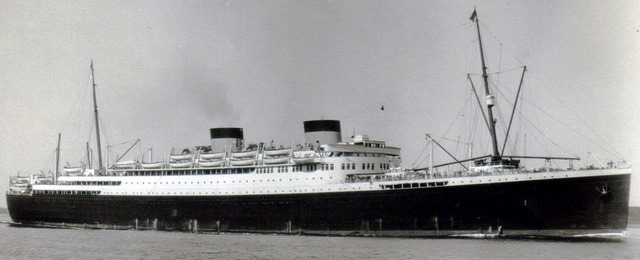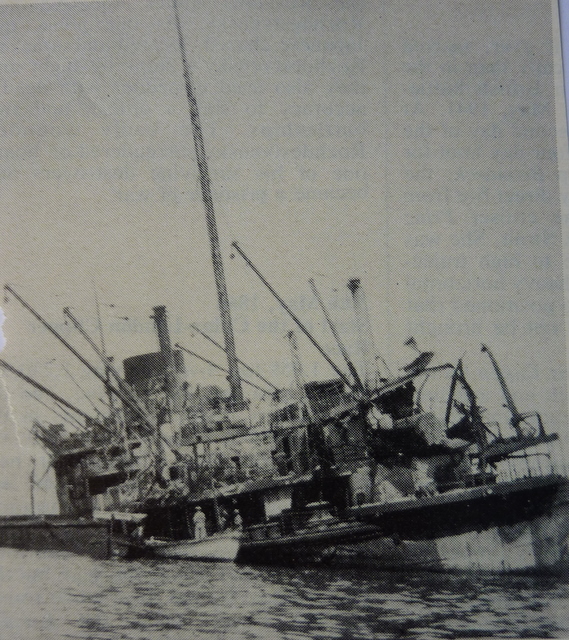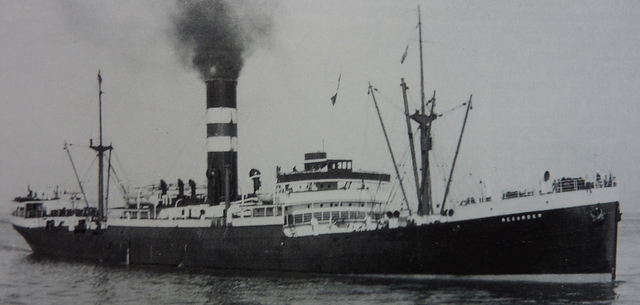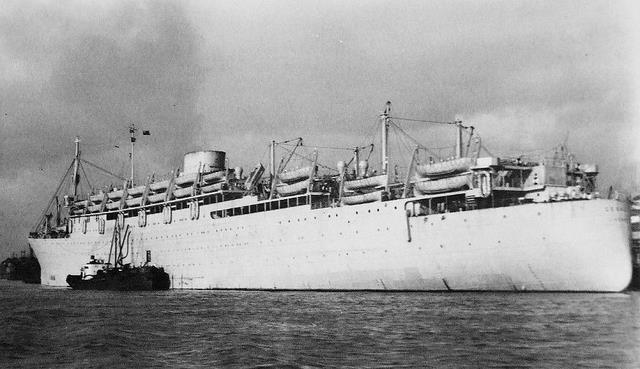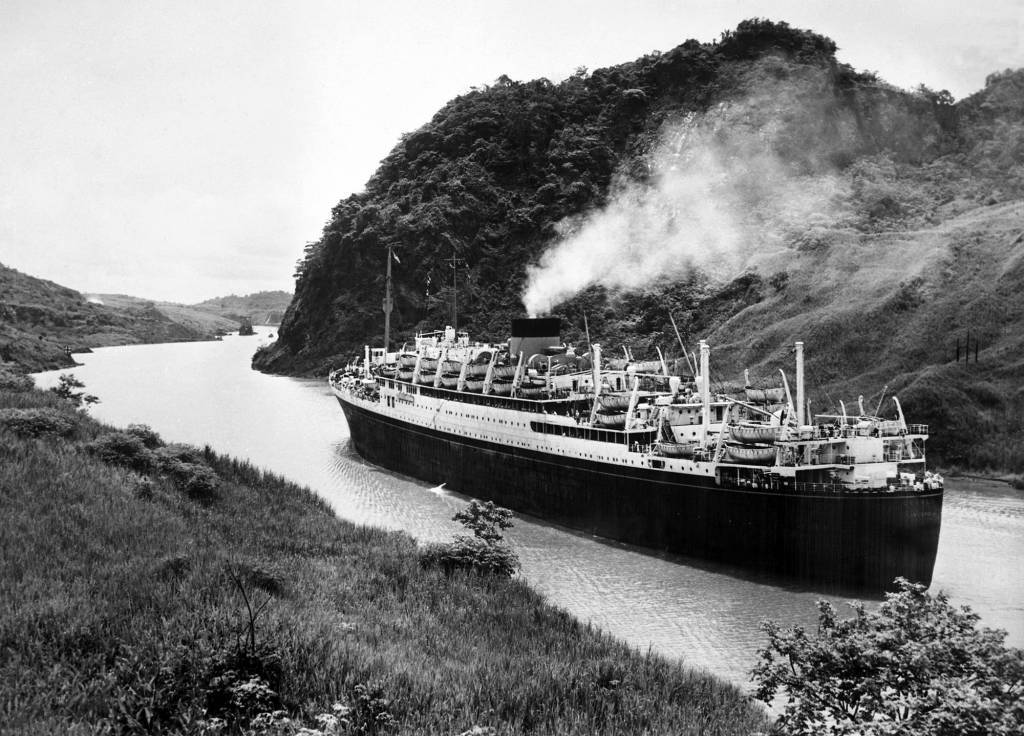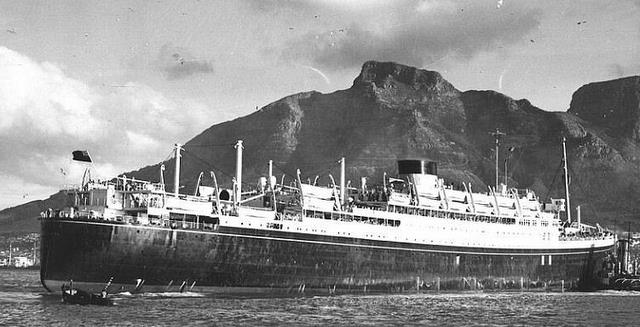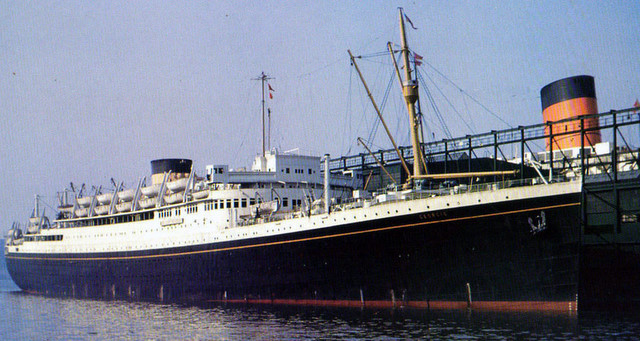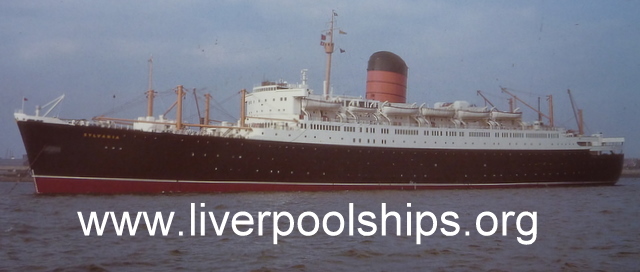THE CUNARD WHITE STAR LINERS 'BRITANNIC ' AND 'GEORGIC'
The White Star liners BRITANNIC (1931) and GEORGIC (1932) became part of the Cunard White Star Line fleet after the merger of 1934.
An imaginary meeting of the BRITANNIC and the GEORGIC at Liverpool, painted by Captain Stephen J. Card
THE CUNARD - WHITE STAR MERGER OF 1934
The Cunard Line's great rival on the North Atlantic express passenger service, the White Star Line, reported trading losses in each year from 1930 to 1933, and by the end of 1933 the Company was bankrupt.
On 30th December 1933 the Directors of the Cunard Line and the Oceanic Steam Navigation Company (the White Star Line) met to put together details of a merger.
On 28th March 1934, Royal assent was given to the North Atlantic Shipping Bill by which Cunard - White Star was formed, and registered on 10th May. The was the Government's solution to two difficult problems. The Cunard Line required financial assistance to complete the QUEEN MARY and to build her consort, the QUEEN ELIZABETH, The White Star Line was in a similar situation with three ageing liners operating on the same route as the Cunard Line. It, too, would need cash to replace its fleet.
The solution was to provide finance to complete the two Cunard Queens, and to amalgamate the two companies. A capital of £10 million was agreed, with Cunard holiding 62%. There were ten directors, six from Cunard and four from White Star.
Only two of the White Star Line's passenger ships were suitable for further service with the Cunard Line. These were the relatively new motorships BRITANNIC and GEORGIC.
The BRITANNIC photographed in the Mersey in 1958
______________________________________________________________
BRITANNIC
Built by Harland & Wolff at Belfast in 1930. Yard No: 807 Official Number: 162316 Signal Letters: G D X F Gross Tonnage: 27,666 Nett: 15,811 Length: 683.6 feet Breadth: 82.4 feet Built for the the Oceanic Steam Navigation Co. Ltd. (the White Star Line), and transferred to Cunard White Star in 1934. 2 oil engines Speed: 18 knots
The BRITANNIC alongside her berth in Liverpool Docks
In April 1928, the White Star Line ordered a new passenger liner from Harland & Wolff at Belfast. The new ship would be the first motorship in the fleet, the largest motorship under the British flag, and the second largest such ship in the world, only exceeded by the Italian liner AUGUSTUS.
The new ship was named BRITANNIC and was designed for cabin and tourist-class servicce on the Liverpool - New York run in the summer months, plus extensive winter cruising. As was usual for the White Star Line, the order went to Harland & Wolff at Belfast. The loss of the CELTIC on rocks at Roches Point, at the entrance to Cobh harbour, in December 1928 caused the building of the BRITANNIC to be speeded up.
The BRITANNIC shortly before her launch
The launch of the BRITANNIC from Harland & Wolffs's Belfast yard on 6th August 1929
The BRITANNIC was launched on 6th August 1929 and she left Belfast for three days of trials in the Firth of Clyde on 26th May 1930. Following the successful completion of these trials, the new ship returned to Belfast, and left again on 21st June for Liverpool.
The BRITANNIC being assisted by Alexandra tugs from her berth in Liverpool's Gladstone Dock into the river entrance lock
The BRITANNIC had two funnels of the so-called 'motorship' design. In the opinion of many people, these low squat funnels with their horizontal tops, detracted from her otherwise fine appearance. The forward funnel was a dummy and contained a smokeroom for the engineer officers, plus fresh water and hot water storage tanks. The BRITANNIC's oil engines reduced fuel consumption by 50% when compared to steamships, using 40 tons a day at 17.5 knots. One comment was that her engine room was so cool that it had to be fitted with radiators for winter warmth!
The BRITANNIC leaving the Gladstone River Entrance lock in blustery conditions, bound for Princes Landing Stage, Liverpool.
On 28th June 1930 the BRITANNIC left Liverpool on her maiden voyage to New York, calling at Belfast and Greenock, after which she settled down on her designed route with the CEDRIC, BALTIC and ADRIATIC. The BRITANNIC's passenger accommodation was originally designed for 504 cabin-class passengers, 551 in 'tourist-third-cabin' and 498 in third class. The naming of the first two classes could hardly have been more absurd - 'cabin' class obviously suggests that the other passengers did not have cabins, and 'tourist-third-cabin', a mixture of all three, would suggest that all the passengers, other than those travelling in the premier 'cabin' class, were a third-rate crowd of tourists. These terms were chosen by the Atlantic Conference to set the passage rates in international liners of very varying luxury and comfort. 'Tourist-third-cabin' was normally shortened to 'tourist', and 'cabin class' was simply 'first class' without the extreme luxury of the large mail liners.
The BRITANNIC was probably the largest and finest cabin-class liner in the world when she first came out and introduced new standards of accommodation on the Liverpool to New York route. In 1934 the final crash came for the White Star Line, and the White Star liners which remained after the merger, including the BRITANNIC, retained their White Star Line colours and flew the White Star houseflag above that of Cunard.
Following the merger, the BRITANNIC was transferred to a London - New York service, and she became the largest liner ever to sail up the Thames. The BRITANNIC left London for the first time on 19th April 1935 and remained on this route until the outbreak of war.
The BRITANNIC photographed in London Docks and painted in wartime gray.
On 29th August 1939 the BRITANNIC was requisitioned for service as a troopship. In the initial stages of the war she carried a complement of 3,000 men, but this had been increased to over 5,000 troops by the time the war ended. In September 1939 the BRITANNIC left the Clyde for Bombay, and returned to the UK with British personnel. She operated principally carrying troops across the Atlantic, but made occasional trooping voyages round Africa to Suez.
In 1943 the BRITANNIC carried American troops to the Sicilian landings, but her principal contribution to the war effort was in transporting over 20,000 US troops across the Atlantic in the build-up to the Normandy Landings. By the end of hostilities, the BRITANNIC had carried 180,000 service personnel and had steamed 367,000 miles on war service.
The BRITANNIC as a troopship passing through the Suez Canal in September 1946
Following repatriation work, the BRITANNIC was released in March 1947 and sent to Harland & Wolff at Liverpool who gave her a complete refit before she re-entered service on the Liverpool - New York service. This work took nearly a year and the accommodation was almost entirely rebuilt. Most cabins were provided with private facilties, and the passenger numbers became 429 in first class and 564 in tourist class.
The BRITANNIC in the Gladstone Graving Dock, Liverpool
Captain J. Treasure Jones, Senior First Officer of the BRITANNIC in 1948.
Left to right: The MAURETANIA, the QUEEN MARY and the BRITANNIC together at New York on 17th May 1951
The BRITANNIC alongside Cunard's Pier 90 at New York
On 22nd May 1948 the BRITANNIC left Liverpool on her first post-war commercial voyage to New York and she continued on this route for the next twelve years. Winter cruising became an increasingly important part of her work and in January 1953 the BRITANNIC sailed on a 59-day cruise to the Mediterranean with calls at 22 ports. This cruise was repeated in 1955.
Huskisson Dock, Liverpool, in June 1960. The BRITANNIC (left) is lying on Cunard's New York berth, whilst the SYLVANIA (right) is on the Canadian berth.
On 15th August 1960 the Cunard Line announced that it had decided to withdraw the BRITANNIC at the end of the year. A statement said that the Company's decision had been accelerated by uncertainties resulting from the present unofficial crew strike which was involving the Company in serious losses. This was on top of the already very onerous settlement agreed with the unions which in itself meant the addition of about £750,000 to the Company's annual crew wages bill.
In late 1959 and in 1960 the BRITANNIC's machinery began to give trouble and on one occasion in 1960 crankshaft damage caused her to be held up at New York. She left Liverpool for New York, via Cobh, for the last time on 11th November 1960. Sailing from New York on 25th November, she was back in Liverpool on 4th December. The BRITANNIC had completed 275 peacetime and wartime voyages.
The BRITANNIC alongside her berth at Pier 92, New York, as the QUEEN MARY is assisted into her berth at Pier 90 by Matson tugs.
The BRITANNIC alongside Pier 92 at New York (foreground). The QUEEN MARY and the MAURETANIA are berthed at Pier 90, and beyond them are the piers for the French Line, Greek Line and United States Lines. The world-famous 'Market Diner' can just be distinguished directly across the road from the QUEEN MARY's bow.
The BRITANNIC alongside Pier 92,North River, New York. On the left, in the background, is the Empire State Building
The BRITANNIC received a solemn reception as she sailed up to Princes Landing Stage to disembark her 353 passengers. No sirens sounded and there were no crowds waiting to say 'goodbye'. Only the tugs which brought her in were dressed overall in honour of this last voyage.
The foredeck of the BRITANNIC seen from the bridge, November 1960, at New York
The BRITANNIC's boat deck, port side, looking aft, at New York on her final voyage, November 1960.
John Prescott, a 62 year old liftman, had been on her maiden voyage. He said: "She's a wonderful ship - so comfortable and so steady even in the worst seas." The head waiter, Charles Leach, had been with Cunard for 42 years and attended to the captain's table for the last time. "Things are much less formal on ships these days," he said, "but the BRITANNIC never changes. I'll be very sorry to see her go." In the first-class restaurant, adjacent to the main doors, was a gaily decorated Christman tree which would never see Christmas.
The BRITANNIC spent much of the winter employed in cruises from New York to the Mediterranean. She is seen alongside at Haifa in this photograph dated 1951.
The BRITANNIC at anchor off Istanbul on a winter sunshine cruise in the 1950s
The BRITANNIC was sold quickly for demolition and on 16th December 1960 she left the Mersey for the last time under her own steam for Thomas W. Ward's yard at Inverkeithing, Fife, where she arrived on 19th December. The BRITANNIC was the last ship to fly the famous White Star Line houseflag, and she had been of immense value to her country in war time, and to both her owners.
Breaking up operations commenced in early February 1961 when the interior fittings were stripped out; many of these were sold at auction.
In 1957 the Cunard Line announced that it had reserved a berth at John Brown's Clydebank yard to build a replacement for the BRITANNIC. With sea travel rapidly being overtaken by the airlines in the late 1950s, this was cancelled and in 1961 the SYLVANIA took over the Liverpool - Cobh - New York service and remained on the route until the final sailing in November 1966.
The BRITANNIC's bell and steam-operated, triple-chime whistle are stored at the Merseyside Maritime Museum. ######
The BRITANNIC arriving alongside Princes Landing Stage, Liverpool on 22nd May, 1948, ready to embark passengers for her first post-war commercial voyage to New York, via Cobh. ___________________________________________________________
GEORGIC
Built by Harland & Wolff at Belfast in 1932. Yard No: 896 Official Number: 162365 Call Sign: L H R F Gross Tonnage: 27,759 Nett: 16,839 Length: 683.6 feet Breadth: 82.4 feet Built for the Oceanic Steam Navigation Co. Ltd. (White Star Line), and transferred to Cunard - White Star in 1934 Two oil engines. Speed: 18 knots
The GEORGIC leaving Liverpool on her maiden voyage to New York on 25th June 1932
The GEORGIC was launched at Belfast by Harland & Wolff for the White Star Line on 12th November 1931. She was the final ship to be built for the White Star fleet. She differed from her sister, the BRITANNIC, completed two years earlier, in a number of respects. The GEORGIC was designed on ambitious lines with an almost straight stem, cruiser stern, and the then fashionable squat funnels with tops parallel to the deck. Unlike her sister, the GEORGIC had a rounded bridge front. Slightly larger than the BRITANNIC, her original accommodation was for a total of 1,636 passengers: 479 in first class, 557 in tourist class and 600 in third class.
The GEORGIC nearing completion at Harland & Wolff's shipyard at Belfast in October 1931
The GEORGIC leaving the Harland & Wolff yard at Belfast on her way to her sea trials.
In April 1931 it was reported that construction work on the GEORGIC was to be speeded up so that she could enter service in May 1932 instead of June as was originally intended. Behind this idea was the fact that some 25,000 Americans were due to visit Dublin to attend the Eurcharistic Conference that was to be held there from 22nd until 29th June. As it turned out the GEORGIC was not completed in time for the Conference and she began her maiden voyage on 25th June when she left Liverpool for New York.
The GEORGIC approaching Princes Landing Stage at Liverpool on 25th June 1932 on the occasion of her maiden voyage to New York
The GEORGIC's forward funnel was a dummy and housed the radio room and the engineers' smokeroom. She was designed as a cabin-class ship, but her passengers had surroundings and comfort equal to those provided in any de-luxe liner of the day. The GEORGIC's trials took place in early June 1932 and a large party of guests was taken to join the ship in the Belfast Steamship Company's motorship ULSTER MONARCH, which was specially chartered for the occasion. The completion of the GEORGIC attracted great attention, and in welcoming her to the Mersey for the first time, the Lord Mayor of Liverpool offered his congratulations to the owners. The GEORGIC made the outward passage of her maiden voyage to New York in rough weather, but even so managed to arrive some twelve hours ahead of schedule.
In November 1932 the GEORGIC's sailing was brought forward by two days in order that she could fit in with the postal arrangements for Christmas mail to the United States. On 11th January 1933 she made her first sailing from Southampton to New York, having moved south to replace the OLYMPIC whilst that vessel underwent an extensive engine overhaul.
A record fruit cargo of 51,687 cartons, representing about 3,000 tons, was discharged by the GEORGIC at Liverpool in October 1933. On 10th May 1934 the vessel was amalgamated into the Cunard - White Star fleet. In June 1934 the GEORGIC was turned into a floating ballroom in aid of the David Lewis Liverpool Northern Hospital's bulding fund, During January 1935 there was a fire among some cotton bales in the ship's forward hold.
On 3rd May 1935 the GEORGIC joined the BRITANNIC on the London (King George V Dock) - New York service, and became the largest vessel to use the Thames, being fractionally larger than the DOMINION MONARCH. In 1939 the GEORGIC reverted to the Liverpool - New York service and made five round trans-Atlantic voyages on commercial service with cargo and passengers, although she was hampered by the fact that Americans had been ordered not to travel on her as she was a belligerent ship. Whilst she was homeward bound on 11th March 1940, Cunard - White Star was informed that she would be taken off commercial service and after discharging a large cargo at Liverpool, the GEORGIC was ordered to the Clyde on 19th April where she was converted into a troopship for 3,000 men.
At the end of May 1940, the GEORGIC assisted in the evacuation of British troops from Andesfjord and Narvik, and as soon as she had landed these men at Greenock, she sailed south to assist in the withdrawal from Brest and St Nazaire. The GEORGIC was under repeated air attack and was indeed fortunate in not being hit. Between July and September 1940 the GEORGIC made a trooping voyage to Iceland and another to Halifax, N.S., embarking Canadian troops after landing the evacuees she carried on the westbound passage. From September 1940 until January 1941 the GEORGIC was employed on a trooping voyage from Liverpool and Glasgow to the Middle East via the Cape of Good Hope, and afterwards trooped from Liverpool to New York and Halifax, and then back to the Clyde.
On 22nd May 1941 the GEORGIC left the Clyde under the command of Captain A.C. Greig, OBE, RNR, with the 50th Northumberland Division for Port Tewfik, Gulf of Suez. She was part of the convoy which had to be left almost unprotected during the hunt for the BISMARCK. She arrived safely on 7th July 1941, but a week later on 14th July she was bombed by German aircraft operating from Crete while at anchor off Port Tewfik, with 800 Italian internees on board. Her fuel caught fire and ammunition exploded in the stern area.
The hulk of the GEORGIC at Port Tewfik
The GEORGIC was gutted and the engine room flooded, but her crew managed to slip the anchor cable and beach the ship on 16th July, half submerged and burnt out. On 14th September 1941 it was decided to salvage the vessel and the hulk was raised on 27th October. The hull was plugged and on 2nd December the GEORGIC was taken in tow by the CLAN CAMPBELL and the CITY OF SYDNEY. She reached Port Sudan on 14th December where she was made seaworthy. It had taken twelve days for the tow to cover 710 miles.
The GEORGIC left Port Sudan on 5th March 1942 and was towed by T. & J. Harrison's RECORDER, with the tug ST SAMPSON steering from astern. On the following day a strong north-westerly gale rendered the wallowing GEORGIC almost unmanageable. The southerly course had to be abandoned and the ships hove-to. For five hours the RECORDER battled to bring her charge head to wind, and in the process the tug ST SAMPSON was damaged. The tug was rapidly filling with water and slipped her tow rope and headed down wind. Shortly afterwards she foundered and her crew were picked up by the hospital ship DORSETSHIRE, which was passing at the time.
The Harrison Line's RECORDER towed the GEORGIC from Port Sudan to Karachi, a distance of 2,100 miles in 26 days
For twelve hours the RECORDER and the GEORGIC rode out the gale and then, as the winds abated, cautiously swung back through 180-degrees to resume their course. Meanwhile they were joined by another tug, the PAULINE MOLLER and the British steamer HARESFIELD. Together they guided their labouring charge past Abu Ail and the islands of the southern Red Sea into the Gulf of Aden, and on to Karachi. The salvage crew responsible for the GEORGIC lived on board the RECORDER and every few days boarded the liner from a motor launch in order to pump out a steady ingress of water.
On 31st March 1942, twenty-six days out of Port Sudan, the ships arrived off Karachi where the GEORGIC was taken in hand by eight harbour tugs. The RECORDER and her consorts, having covered 2,100 miles with the GEORGIC, had completed one of the most successful salvage operations of the war. Captain W.B. Wilford of the RECORDER was later invested with the OBE.
The GEORGIC remained at Karachi until 11th December whilst temporary repairs were carried out. She then sailed to Bombay, arriving on 13th December, where she was dry-docked for hull cleaning and further repairs. Finally, she loaded 5,000 tns of pig iron ballast and on 20th January 1943 the GEORGIC left Bombay under her own power for Liverpool where she arrived on 1st March, having made the passage at 16 knots. Shortly afterwards she sailed for Belfast, but had to anchor in Bangor Bay until 5th July awaiting a berth. After seventeen months the GEORGIC emerged on 12th December 1944 with one funnel and a stump foremast. She was now owned by the Ministry of Transport, with Cunard - White Star as managers. After trials the GEORGIC left Belfast for Liverpool on 16th December 1944, three years and five months since she was bombed at Port Tewfik.
The GEORGIC as a troopship in 1945 after her rebuild
During 1945 the GEORGIC trooped to Italy, the Middle East and India. On Christmas Day she arrived in Liverpool with troops from the Far East, including Sir William Slim, C-in-C of South East Asia. Early in 1946 the GEORGIC repatriated 5,000 Italian prisoners-of-war. In June 1946, on a homeward voyage from Bombay, there was trouble between civilian women and service women on board, and this led to a barring of civilians on troopships unless no other transport was available.
The GEORGIC disembarking troops at Liverpool's Princes Landing Stage in 1946
In September 1948 the GEORGIC was refitted by Palmers & Company at Hebburn for the Australian and New Zealand emigrant trade. She retained her White Star livery and could accommodate 1,962 passengers in one class. In January 1949 the GEORGIC made her first sailing on the Liverpool - Suez - Fremantle - Melbourne - Sydney run with 1,200 'assisted passages'. However, as she was leaving Princes Landing Stage, Liverpool, a rope wrapped round one of her propellers and she had to re-dock. During the summers 1950 - 1954, the GEORGIC was chartered back to Cunard and she made seven round voyages to New York each year as a one-class liner. In 1950 she was based at Liverpool, but Southampton was her terminal port from 1951 until 1954.
The GEORGIC photographed passing through the Panama Canal
The GEORGIC at Cape Town carrying 'assisted passage' emigrants to Australia
In the winter of 1954/55 the GEORGIC resumed 'assisted passage' voyages to Australia, and on 16th April 1955 she arrived at Liverpool with troops from Japan. She was then offered for sale, but the Australian government chartered her for the summer. The GEORGIC's final voyage was from Hong Kong to Liverpool with 800 troops, and she arrived on 19th November 1955.
The GEORGIC berthed on the south side of Pier 90, New York, whilst on summer charter to the Cunard Line from 1950 to 1954. Note the funnel of the QUEEN ELIZABETH on the north side of Pier 90.
On 11th December the GEORGIC was laid up at Kames Bay, Isle of Bute, Firth of Clyde, pending disposal. In January 1956 the GEORGIC was sold for demolition and on 1st February arrived at Faslane for scrapping by Shipbreaking Industries Ltd. <<<<<<<>>>>>>>
The GEORGIC as she appeared in the post-war years
______________________________________________________________________
|

